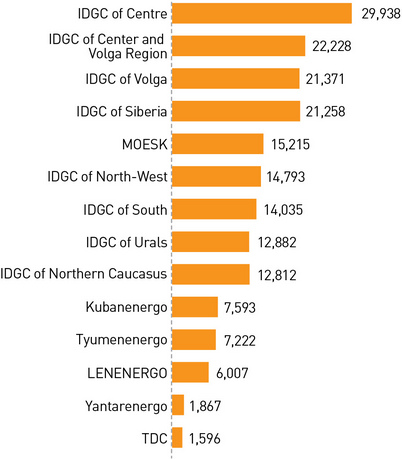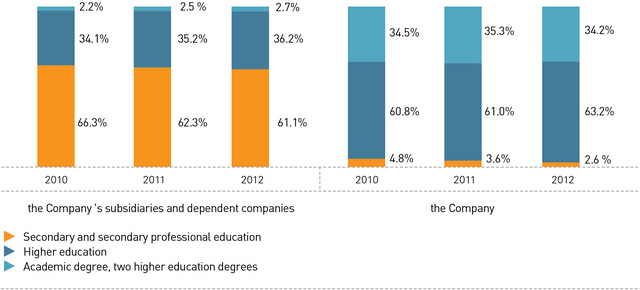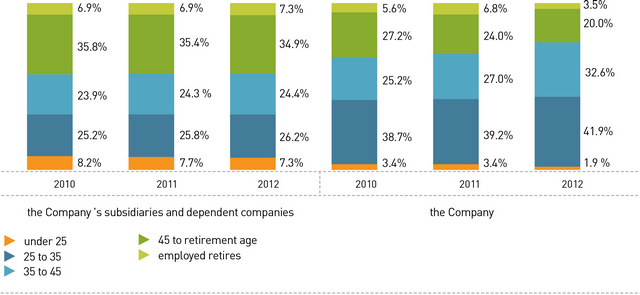Human Capital and Social Responsibility
HUMAN CAPITAL
A key area of the Company’s personnel policy is to retain, replenish, and develop the human assets of distribution grid companies with due consideration to the development prospects of the electric grid sector and the priority given to a reliable power supply for customers.
Electric grid companies are the industry’s largest employer with a total staff of about 190 thousand. Treating our employees as human resources rather than labor resources is more than simply a declaration; it is a principle embodied in our consistent human resources policy.
The goal of investing in human resources is to raise the market capitalization of the companies and make them more attractive to investors. The human resources policy is based on partner relationships with employees, our commitment to fulfill social and occupational safety obligations, investment in personnel development, and equal opportunities for career development.
The staff on the payroll of the Company subsidiaries in 2012 was 188.8 thousand people, or 1.7 thousand more than in 2011, with the staff on the payroll of the management company being 344 people.
The quality of the workforce potential of electricity distribution grid companies are demonstrated by a high supply of labor (97% of the required number of employees in recent years) and low personnel turnover (subsidiaries’ average ratio between voluntary resignations and the staff on the payroll was 6% in 2012).
An analysis of qualitative characteristics of personnel proves the effectiveness of measures taken under the uniform human resources policy. The educational level of employees becomes higher in both managed entities and the management company.
As at the end of 2012, 97.4% of the Company employees had higher education, with 9% of them holding candidate of science or doctor of science degrees.
Subsidiaries succeeded in continuing to demonstrate a trend in having increasing numbers of employees with higher education even though some companies took on the functions that had previously been outsourced – maintenance and transportation services – with a small share of employees having higher education. Such a high percentage of employees having secondary and secondary professional education is due to the fact that blue-collar jobs account for a large share in the electricity distribution sector’s occupations (54% as at the end of 2012).
The Company’s companies give much attention to the training, retraining, and advance training of personnel. In 2012 there were more than 167 thousand people, who participated in training courses, 87.8% of the staff on the payroll completed training courses (87.6% in 2011). Training encompasses a wide range of programs – from compulsory training programs for operational personnel in accordance with rules for personnel relations to programs aimed at developing professional and managerial competencies of the employees included in the personnel reserve of the companies.
As at the end of 2012, 97.4% of the Company employees had higher education, with 9% of them holding candidate of science or doctor of science degrees.
Subsidiaries succeeded in continuing to demonstrate a trend in having increasing numbers of employees with higher education even though some companies took on the functions that had previously been outsourced – maintenance and transportation services – with a small share of employees having higher education. Such a high percentage of employees having secondary and secondary professional education is due to the fact that blue-collar jobs account for a large share in the electricity distribution sector’s occupations (54% as at the end of 2012).
The Company’s companies give much attention to the training, retraining, and advance training of personnel. In 2012 there were more than 167 thousand people, who participated in training courses, 87.8% of the staff on the payroll completed training courses (87.6% in 2011). Training encompasses a wide range of programs—from compulsory training programs for operational personnel in accordance with rules for personnel relations to programs aimed at developing professional and managerial competencies of the employees included in the personnel reserve of the companies.
As of the end of the reporting year, workers accounted for 58% of the total trained personnel. The corporate network of regional training centers has a major role in the organization of training for technical personnel of electricity distribution grid companies. The network comprises 20 licensed nonprofit educational institutions established by interregional distribution grid companies. In 2012, in-house training centers provided training for 29,500 employees of subsidiaries and dependent companies (18% of the total trained personnel).
Special attention is paid to the training of personnel responsible for ensuring the reliable operation of electric grid and substation equipment. This section of training measures not only aims to raise the professional level of employees but also provides training under programs designed to reduce the occupational injury risk and prevent accidents from occurring through the fault of personnel.
Twenty regional licensed training centers founded by interregional distribution grid companies work to satisfy the main demand for operational personnel training. About 29.5 thousand employees of the companies were provided with training under the training centers’ programs in 2012. In cooperation with their founders, the training centers regularly update the lists and contents of their training programs in line with electricity distribution grid companies’ needs, renew their teaching aids, and adopt new training techniques using up-to-date multimedia systems.
Extensive efforts to recruit young employees contribute to the Company’s companies retaining and, in some instances, improving the age characteristics of personnel. A third of electricity distribution grid companies’ employees is young people aged 35 or below.
The Company’s attitude toward personnel as a valuable asset is evidenced by how scrupulously Holding’s companies treat the formation of their personnel reserves and the development of personnel reserve members. Employee career management is viewed as long-term investment that contributes to personnel accumulating specific professional and managerial skills.
Holding’s companies have the following types of personnel reserves:
- Managerial personnel reserves;
- Youth personnel reserves;
- Reserves of critical occupations (not in all companies).
Managerial personnel reserves are established in the executive arms of interregional distribution grid companies and their branches for senior and middle-level management positions in order to have employees with the requisite experience, managerial qualities, and leadership competencies when it is necessary to promptly fill any vacancies.
The principal criteria for including an employee in the managerial personnel reserves are as follows:
- High professional qualifications;
- Operating efficiency;
- Potential necessary for professional development and career development;
- High trainability;
- Motivation for career development;
- Leadership qualities;
- Mobility (readiness to move from one area to another).
Training of a personnel reserve member for his/her target position starts with formulating an individual development plan that takes account of the candidate’s professional and managerial experience and the development level of his/her competencies. The plan consists of various measures and includes the mastering of theoretical skills, participation in training programs and events, traineeships, and temporary duty in his/her target capacity.
The managerial personnel reserves of distribution grid companies comprise about 11 thousand employees and executives.
With the aim of involving young employees in tackling the electric grid sector’s burning issues, raising their professional competencies, and helping them with their career development, the Company worked in 2012 to form youth personnel reserves. The youth personnel reserves of interregional distribution grid companies were established as part of pursuing the uniform youth policy of the Company and its subsidiaries.
The youth personnel reserves are made up of young employees aged 35 and below selected from among the most promising personnel with the high potential for development and with the motivation for professional development and career development.
The youth personnel reserve of distribution grid companies is established at three levels: branches, interregional distribution grid companies, and the Company. The reserve consists of more than 2,500 people.
Target job positions are assigned to youth personnel reserve members, mentors are appointed from among the most qualified and competent employees, and each personnel reserve member has an individual development plan containing a set of developing measures aimed at preparing him or her for the target job position.
In addition to mentors, the process of developing personnel reserve members involves their immediate superiors and human resources personnel. This manner of dealing with the personnel reserve ensures that young employees will acquire the experience of interregional distribution grid companies’ best professionals and helps young employees master up-to-date techniques used by Russian and foreign electric utilities.
In accordance with individual development plans, training events were organized for youth personnel reserve members in 2012 to enable them to gain more professional knowledge, master modern approaches to managerial functions, and acquire skills in planning their own activities and improving their personal efficiency.
Subsidiaries and dependent companies find it important to ensure that the theoretical skills acquired by personnel reserve members at workshops and training events are reinforced by their practical use. In order for young employees to gain the experience of performing their functions in target job positions, they were involved in dealing with problem situations typical of their target job positions, included in project teams and task forces addressing topical issues of electricity distribution, and appointed to carry out duties in their target capacity while the relevant regular employees were temporarily absent.
A comprehensive approach to the development of professional and managerial competencies allowed many personnel reserve members to gain necessary knowledge, skills, and expertise within a short time. In 2012, over 350 youth personnel reserve members moved to a more senior role in the Company’s entities (including 200 people promoted to their target job positions).
Some of the Company’s entities have personnel reserves for key positions (generally, operating and maintenance personnel). These personnel reserves are established with the aim of preserving unique professional experience of electricity distribution grid companies’ employees whose work is vital to the reliable functioning of power facilities and the uninterrupted electricity supply.
Given the importance of their functions and the stringent requirements applicable to qualifications for key positions, newly appointed employees need a long time to acquire necessary knowledge, skills, and expertise. Selecting personnel reserve candidates for key positions and providing personnel reserve members with training on a goal-oriented basis make it possible for employees to substantially reduce the period of mastering their duties in key positions and ensure that the most important positions occupied by employees of preretirement and retirement age will be provided with suitably qualified replacement personnel.
The personnel reserves for key positions at subsidiaries and dependent companies consisted of about 50 employees in 2012. Each of them had a mentor having unique professional experience and communicating it to the personnel reserve member. In addition, personnel reserve members were sent to participate in educational programs related to their professional functions.
SOCIAL RESPONSIBILITY
The Company has high standards of social responsibility to its employees. All of the Company’s entities are members of the All-Russia Trade Association of Employers in the Power Industry (RaEl Association), which, together with the All-Russian Electrounion, is a party to the social partnership at federal industry level.
Collective bargaining agreements are based on the Sectoral Wage Rate Agreement in the Russian electricity sector for 2009–2011, which is the main legal instrument that governs social and labor relations in electric utilities.
Taking account of accumulated practical experience and regional employment market conditions, the collective bargaining agreements set forth the employer’s obligations with respect to working hours and rest periods, salaries and wages, and additional benefits, guarantees, and compensation, as well as the obligations of primary labor union organizations. In 2012, the Company’s entities fulfilled all of the obligations contained in the Sectoral Wage Rate Agreement and collective bargaining agreements.
The terms and conditions of collective bargaining agreements were independently examined by the All-Russia Trade Association of Employers in the Power Industry (RaEl Association) for compliance with the obligations contained in the Sectoral Wage Rate Agreement.
Distribution grid companies continued in 2012 to carry out the non-state pension coverage programs. Priority was given to the Corporate Plan – Support Program, as well as the Parity Plan and the Cofinancing Program combining pension accruals financed by both the Company and employees.
With a view to raising social protection, the electricity distribution grid sector’s employees were provided in 2012 with voluntary health insurance and personal accident and sickness insurance in accordance with the approved insurance coverage programs of subsidiaries and dependent companies.
Voluntary health insurance agreements enabled employees to receive additional medical care from the country’s leading diagnostic and treatment centers on top of what they were entitled to under the Program of Government Guarantees for Free Medical Services Provided for Russian Federation Citizens.
The result of the work done by the Award Nomination Commission of the Company in 2012 is awards granted to employees, namely:
- 2,572 employees of the Company received corporate awards;
- 806 employees of the Company received official awards;
- 82 employees of the Company received governmental awards.
The Company gives special attention to promoting sports and safeguarding the health of personnel. The year 2012 witnessed the fourth all-Russia summer and winter corporate games among distribution grid companies’ employees. Held in Moscow, the finals welcomed 14 picked teams with over 350 athletes in the summer (futsal, volleyball, athletics, weightlifting, and energy relay races) and more than 210 in the winter (cross-country skiing, swimming, table tennis, and chess).
LENENERGO in Saint Petersburg hosted the 2nd All-Russia Humorous Acting Game held among the electricity distribution grid sector’s employees from May 27 to June 1, 2012.
In 2012, the Company held the traditional Children’s Drawing Contest “Unified Grid – Unified Country,” initiated by FGC UES and the Company. The contestants were over 1,000 young artists aged between 4 and 14, children of employees of the Company’s executive arm and subsidiaries and dependent companies and FGC UES’s branches (electricity transmission grids).
Pensioners are the most vulnerable to changes in the country’s socioeconomic policy; therefore, a priority of the Company’s social policy is to provide social support for its former employees, namely retirees. Work continues in this area under the Non-State Pension Coverage Program in the form of non-state pension payments.
Additionally, retirees receive benefit payments in connection with jubilees, bad financial condition, and medical treatment. On the occasion of public and professional holidays (Defender of the Fatherland Day, Victory Day, and International Day of Older Persons), cultural events are organized for retirees.
Made up of more than 52,000 veterans and retirees of the Company and its subsidiaries and dependent companies, the electricity distribution grid sector’s Coordinating Council of Veterans works to consolidate the Company’s veteran movement.
As part of celebrations to mark the 67th anniversary of the Victory in the Great Patriotic War, the Company in 2012 organized events in collaboration with the chairmen of the Councils of Veterans and the Councils of Youth of subsidiaries and dependent companies.
The electricity distribution grid sector’s employees took an active part in the From the Heroic Deed Homeland to the Hero’s Homeland international commemorative campaign, starting in the Pskov Region. As part of this campaign, the Company’s entities received copies of the Victory Banner and, as scheduled, held ceremonies in all electric grid districts with these banners given to electric grid districts’ teams.
In 2012, veterans and young employees of the Company and its subsidiaries and dependent companies took part in the Let’s Conserve Forest Energy event. The Company provided veterans with the opportunity to visit new and rehabilitated power facilities (substations and network control centers), museums, and memorials.



